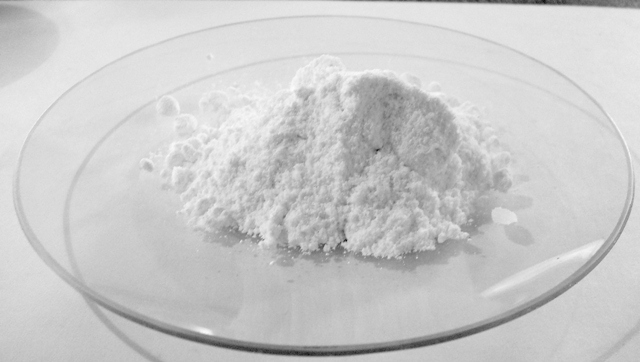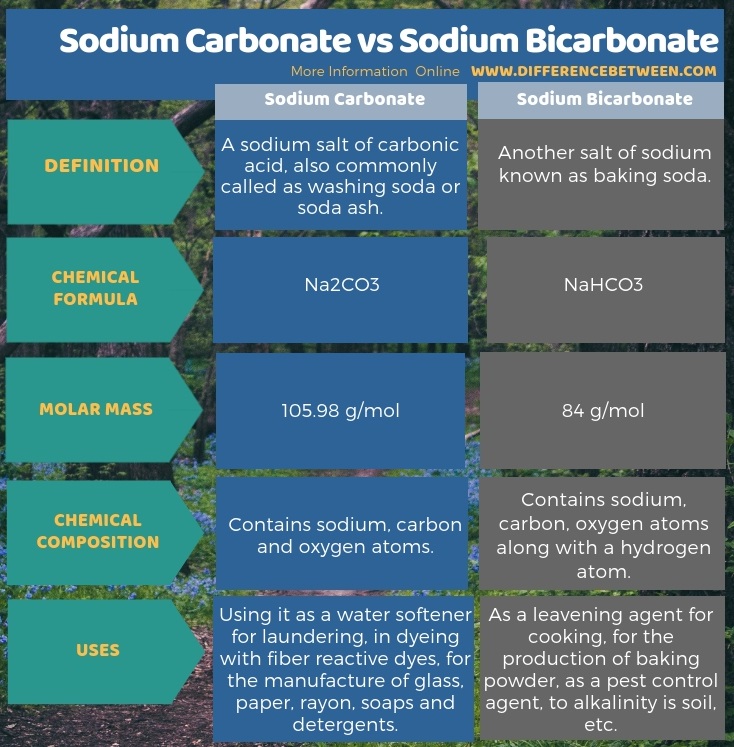Difference Between Sodium Carbonate and Sodium Bicarbonate
Sodium carbonate (Na2CO3), commonly called as washing soda or soda ash, is a sodium salt of carbonic acid whereas, sodium bicarbonate (NaHCO3), known as baking soda, is another salt of sodium. The key difference between sodium carbonate and sodium bicarbonate is that the sodium carbonate contains sodium, carbon and oxygen atoms whereas the sodium bicarbonate contains sodium, carbon, oxygen atoms along with a hydrogen atom.
Sodium Carbonate and Sodium Bicarbonate are two sodium salts that are common in many products we use in homes. Sodium is a metallic element represented by the symbol Na. It is a soft, white in color, reactive metal that is not found naturally and is mostly found in the form of its oxides. It makes oxides when it comes in contact with air and also reacts quickly with water. The element sodium is essential for all living things and is useful in opposition to potassium ions. It allows for the transmission of nerve impulses and is thus we consider it as essential for human beings. Sodium is highly reactive and makes various compounds such as common salt (NaCl), Baking Soda (NaHCO3), soda ash (Na2CO3), caustic soda (NaOH) etc.
This article intends to find the difference between sodium carbonate and sodium bicarbonate.
CONTENTS
1. Overview and Key Difference
2. What is Sodium Carbonate
3. What is Sodium Bicarbonate
4. Side by Side Comparison – Sodium Carbonate vs Sodium Bicarbonate in Tabular Form
5. Summary
What is Sodium Carbonate?
Sodium carbonate, commonly called as washing soda or soda ash, is a sodium salt of carbonic acid. People recall it as a water softener as it is frequently useful in homes. It has an alkaline taste (with a cooling sensation). We can extract Na2CO3 from the ashes of many plants. When required in large quantities, we can make it from common table salt (NaCl) through a process called Solvay process. Among its many industrial uses, Na2CO3 is useful in manufacturing glass. When we heat silica and calcium carbonate along with sodium carbonate and cooled suddenly, it forms glass. This is a special type of glass aptly; we name it as soda lime glass.
Uses
As sodium carbonate is a strong base, it is useful in swimming pools to neutralize the effect of chlorine. It is also important as a lying agent in making lye rolls. When making some dishes, we use sodium carbonate to change the pH of the surface of the food and to give it a brown color. In biological studies, we can add sodium carbonate to boiling water to wash the skulls and boney parts of bodies to remove flesh from the bones. Sodium carbonate is important as an electrolyte in chemistry because it is a very good conductor and aids in the electrolysis process. Acid-base titrations also make heavy use of sodium carbonate.

Figure 01: Sodium Carbonate
As described earlier, in homes we use it as a water softener. Hard water contains ions of magnesium and calcium that add to the detergent disallowing formation of lather. Sodium carbonate soaks up these ions making the water soft and ideal for washing clothes. Moreover, we call it washing soda because of its ability to remove stains, oil and grease spots from clothes.
Sodium carbonate is useful as a food additive in the food industry on a large scale as an acidity regulator. In the brick industry, it acts as a wetting agent and in the casting industry, it acts as a bonding agent. It is useful in kinds of toothpaste to work as a foaming agent. It is even used to clean silverware.
What is Sodium Bicarbonate?
Sodium bicarbonate is another salt of sodium known as baking soda. This is actually sodium hydrogen carbonate since there is a hydrogen atom with a lack of one sodium ion. Sodium bicarbonate is a white solid but mostly found as a powder. It has the same alkaline taste of sodium carbonate and is highly soluble in water, which is why it is commonly found in spring waters. People often use it in names such as sodium bicarb or even only carb.

Figure 01: Sodium Bicarbonate
The primary use of sodium bicarbonate is in cooking as a leavening agent. It reacts with other substances causing the release of CO2 which helps to make dough easily. This is why we call it bread soda. In fact, we can use sodium bicarbonate in the place of baking powder if acidic reagents are added. In earlier times, people used sodium bicarbonate for cooking as it made vegetables softer but now it is not in use as it destroys many vitamins and acids that are beneficial to us.
Sodium bicarbonate is an excellent exfoliating agent and hence it is very important for cleaning. It is commonly used in soaps and mouthwashes. Thus, it neutralizes the acid formation in the mouth and prevents teeth and gum decay.
What is the Difference Between Sodium Carbonate and Sodium Bicarbonate?
Sodium carbonate is a sodium salt of carbonic acid whereas sodium bicarbonate (or baking soda) is another salt of sodium. Sodium carbonate contains sodium, carbon and oxygen atoms whereas the sodium bicarbonate contains sodium, carbon, oxygen atoms along with a hydrogen atom. This is the key difference between sodium carbonate and sodium bicarbonate. Also, sodium carbonate has the chemical formula Na2CO3 and the molar mass is 105.98 g/mol. On the other hand, sodium bicarbonate has the chemical formula NaHCO3 and the molar mass is 84 g/mol.
The difference between sodium carbonate and sodium bicarbonate can be highlighted based on the usage as well. The uses of sodium carbonate include using it as a water softener for laundering, in dyeing with fiber reactive dyes, for the manufacture of glass, paper, rayon, soaps and detergents. The uses of sodium bicarbonate include as a leavening agent for cooking, for the production of baking powder, as a pest control agent, to alkalinity is soil, etc.
The below infographic presents the difference between sodium carbonate and sodium bicarbonate in tabular form for quick reference.

Summary – Sodium Carbonate vs Sodium Bicarbonate
Sodium carbonate and sodium bicarbonate have nearly similar chemical structures with a slight difference. The difference between sodium carbonate and sodium bicarbonate is that sodium carbonate contains sodium, carbon and oxygen atoms whereas sodium bicarbonate contains sodium, carbon, oxygen atoms along with a hydrogen atom.
Reference:
1. “Sodium Carbonate.” Wikipedia, Wikimedia Foundation, 12 Sept. 2018. Available here
2. “Sodium Bicarbonate.” Wikipedia, Wikimedia Foundation, 9 Sept. 2018. Available here
Image Courtesy:
1.”Uhličitan sodný”By Ondřej Mangl – Own work, (Public Domain) via Commons Wikimedia
2.”Sodium bicarbonate”By Thavox – Own work, (Public Domain) via Commons Wikimedia
ncG1vNJzZmivp6x7pbXFn5yrnZ6YsqOx07CcnqZemLyue8OinZ%2Bdopq7pLGMm5ytr5Wau26%2Fzp2grqVdmK6zrs6nmK2dXZa7pXnVrGSsp5Sewq55waKamqqSpLuiwMRo